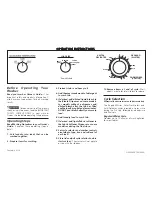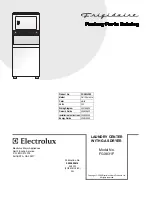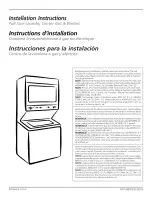
Operating Instructions Ascoline 850, MEB 4xx, 6xx
ascobloc
Gastro-Gerätebau GmbH
01156 Dresden, Grüner Weg 29
Germany
Tel.: +49 351 4533-0 Fax: +49 351 4537-339
Email:
MEBxxxff.doc Stan: 13.11.2018
Subject to change without notice!
3.3 Instructions for transport
Transport ascobloc equipment only in the original packaging. This avoids unnecessary damage and
expense.
Check equipment for damage.
Do not lift or move the equipment by gripping the top plate, the lower edges of the equipment at the sides
or the door handles. The equipment lower edge at the front and back is provided for this.
3.4 Installation instructions
The equipment is wired-up internally in the works as far as the power supply connector. All external
connection work must be carried out by an authorised specialist company. Let the specialists look at
these documents. The legally recognised regulations (Germany VDE, Austria ÖVE, Switzerland SEV etc.)
and the connection conditions of the local electricity utility are to be observed.
Before beginning the installation work, it should be checked that the mains voltage, mains type and the
current rating of the fuse match the values given on the type plates. An isolating device in the customer's
scope of supply that is effective on all poles must be provided, e.g. contactor fuses with at least 3 mm
contact gaps, so that the equipment is disconnected from the power supply during repair and installation
work. Connection to an equipotential bonding system is available (check effectiveness).
Do not sharply bend or pinch power supply cables or damage them on sharp edges and route them so
that they do not come in contact with hot parts. The power supply cable must be led through the
equipment, fully sheathed, from the screwed connection to the entry of the terminal box. The equipment
is intended for a permanent connection; connection via plug and socket is not permitted
4
Installation
4.1 Setting up
Do not set up the equipment next to walls, kitchen furniture, and decorations or similar which are made of
flammable materials. Otherwise there is danger of fire. See connection diagram with equipment
description for minimum distance. Local fire protection regulations must be kept absolutely!
It is absolutely necessary that the equipment be set up horizontally (use spirit level for alignment) so that
the doors can be opened and closed without any problem and that they seal tightly when closed.
Equipment with adjustable feet can easily compensate for unevenness in the floor (+/- 20 mm) by the
turning of the bottom end of the stainless steel feet. If set up on a plinth, this is to have an underlay if
needed.
4.1.1 Free-standing set-up
If the equipment is to be set up on its own, suitable means are to be used to protect it against tilting and
shifting.
4.1.2 Setting up in groups or blocks
When setting them up in groups or blocks, the equipment must be joined together by connecting
elements provided for this purpose. This is for the sake of hygiene. Observe equipment setting up sheets
or assembly diagram (data sheet in annex).
4.2 Connections
Details of connections for the media can be taken from the accompanying connection diagram and
equipment description. Check whether the size and position of the electrical connections of the customer
side correspond to the information in the connection plan, equipment description or installation plan.
The terminal box for the connections is located behind the front panel A (see data sheet). Make the
connections as shown in the annex or in the connection diagram accompanying the equipment. The
number of the connection diagram is to be found on the type plate. Once the electrical connections have
been made, close the cover of the terminal box and screw the front panel in place again.
4.2.1 Floor-standing appliances
The connections can be made from below or from the rear from a closed installation space. With the
connection from below, the pipe length must be 50 mm above the floor surface.
4.2.1.1
Connection from the rear when equipment on a plinth
The penetrations are to be made according to the known DIN and VDE regulations. The connections can
be through the rear wall (see illustration for dimensions).




























